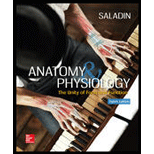
Concept explainers
The clear, structureless gel in a cell is its
- a. nucleoplasm.
- b. protoplasm.
- c. cytoplasm.
- d. neoplasm.
- e. cytosol.
Introduction:
All living organisms are made up of cells and its products. Cells are regarded as the simplest unit (structural and functional) of life. Cellular membrane, nucleus, and cytoplasm are the three major components of a cell. Cellular membrane, which surrounds the entire cell, is composed of phospholipids and proteins. The nucleus is bound by a nuclear membrane, and it possesses the genetic material of the cell. The cytoplasm consists of organelles, cytoskeleton (filaments and tubules), and inclusion bodies.
Answer to Problem 1TYR
Correct answer:
The organelles, cytoskeleton (filaments and tubules), and inclusion bodies present in the cell are dispersed in a clear, structure-less gel known as cytosol. Therefore, option e is correct.
Explanation of Solution
Justify reasons for the correct statement:
Cytosol (cell substance) or intracellular fluid (ICF) is a clear, gel-like substances that is mostly made up of water, water-soluble molecules, and dissolved ions.
Option (e) is given as “cytosol”.
Cytosol is a structure-less, gel-like substance, which fills the cytoplasm of the cell.
Hence, option (e) is correct.
Justify reasons for the incorrect statements:
Option (a) is given as “nucleoplasm”.
Nucleoplasm is a structure-less, gel-like material that fills the nucleus. Hence, it is a wrong answer.
Option (b) is given as “protoplasm”.
Protoplasm denotes all living materials that are present in the cell enclosed by the cellular membrane (inside and outside the nucleus). The protoplasm inside and outside the nucleus is known as nucleoplasm and cytoplasm, respectively. Hence, it is a wrong answer.
Option (c) is given as “cytoplasm”.
The protoplasm that is enclosed within the cellular membrane and outside the nucleus of the cell is called as cytoplasm. Cytoplasm consists of organelles, cytoskeleton (filaments and tubules), and inclusion bodies. Hence, it is a wrong answer.
Option (d) is given as “neoplasm”.
The abnormal tissue growth resulting from rapid and uncoordinated cell division is referred to as neoplasm. Hence, it is a wrong answer.
Hence, options (a), (b), (c), and (d) are incorrect.
The clear, structure-less gel-like substance present in the cell is called as the cytosol.
Want to see more full solutions like this?
Chapter 3 Solutions
Anatomy & Physiology: The Unity of Form and Function
Additional Science Textbook Solutions
Human Anatomy & Physiology
Campbell Essential Biology (6th Edition) - standalone book
Campbell Biology (10th Edition)
Campbell Biology in Focus
Biology Science Notebook
Prescott's Microbiology
- A cell that synthesizes large amounts of protein for use outside thecell has a largea. number of cytoplasmic inclusions.b. number of mitochondria.c. amount of rough endoplasmic reticulum.d. amount of smooth endoplasmic reticulum.e. number of lysosomes.arrow_forwardCytoplasm is founda. in the nucleus.b. outside the nucleus and inside the plasma membrane.c. outside the plasma membrane.d. inside mitochondria.e. everywhere in the cell.arrow_forward__________ ribosomes synthesize soluble proteins. a. membrane-boundb. free c. golgid. endoplasmic e. nuclear envelopearrow_forward
- A large structure, normally visible in the nucleus of a cell, whereribosomal subunits are produced is called a(n)a. endoplasmic reticulum. c. nucleolus.b. mitochondrion. d. lysosome.arrow_forwardWhich of the following is not a component of the endomembrane system?a. mitochondrionb. Golgi apparatusc. endoplasmic reticulumd. lysosomearrow_forwardWhich of the following is not one of the three main parts of the cell? a. cell membrane b. nucleus c. plasma membrane d. cytoplasm e. cytosolarrow_forward
- Which of the following is not a component of the cytoskeleton?a. microtubulesb. actinsc. microfilamentsd. ciliae. cytokeratinsarrow_forwardThe major functions of the Golgi apparatus area. diffusion and osmosis.b. detoxification of substances and removal of wasteproducts.c. synthesis of new proteins for the cytoplasm.d. packaging, sorting, and modification of new moleculesarrow_forwardThe endomembrane system within a cell includes thea. cytoskeleton and the ribosomes.b. prokaryotes and the eukaryotes.c. endoplasmic reticulum and the Golgi complex.d. mitochondria and the chloroplasts.arrow_forward
- This organelle is composed of extensive amounts of membrane. It synthesizes lipids and detoxifies harmful substances such as alcohol. This organelle is a. the smooth endoplasmic reticulum. b. a mitochondrion. c. a proteasome. d. a lysosome.arrow_forwardMatter can leave a cell by any of the following means except a. active transport. d. pinocytosis. b. simple diffusion. e. exocytosis. c. facilitated diffusionarrow_forwardEukaryotic cells containa. a nucleus.b. DNA.c. a plasma membrane.d. mitochondria.e. All of these are correctarrow_forward
 Human Anatomy & Physiology (11th Edition)BiologyISBN:9780134580999Author:Elaine N. Marieb, Katja N. HoehnPublisher:PEARSON
Human Anatomy & Physiology (11th Edition)BiologyISBN:9780134580999Author:Elaine N. Marieb, Katja N. HoehnPublisher:PEARSON Biology 2eBiologyISBN:9781947172517Author:Matthew Douglas, Jung Choi, Mary Ann ClarkPublisher:OpenStax
Biology 2eBiologyISBN:9781947172517Author:Matthew Douglas, Jung Choi, Mary Ann ClarkPublisher:OpenStax Anatomy & PhysiologyBiologyISBN:9781259398629Author:McKinley, Michael P., O'loughlin, Valerie Dean, Bidle, Theresa StouterPublisher:Mcgraw Hill Education,
Anatomy & PhysiologyBiologyISBN:9781259398629Author:McKinley, Michael P., O'loughlin, Valerie Dean, Bidle, Theresa StouterPublisher:Mcgraw Hill Education, Molecular Biology of the Cell (Sixth Edition)BiologyISBN:9780815344322Author:Bruce Alberts, Alexander D. Johnson, Julian Lewis, David Morgan, Martin Raff, Keith Roberts, Peter WalterPublisher:W. W. Norton & Company
Molecular Biology of the Cell (Sixth Edition)BiologyISBN:9780815344322Author:Bruce Alberts, Alexander D. Johnson, Julian Lewis, David Morgan, Martin Raff, Keith Roberts, Peter WalterPublisher:W. W. Norton & Company Laboratory Manual For Human Anatomy & PhysiologyBiologyISBN:9781260159363Author:Martin, Terry R., Prentice-craver, CynthiaPublisher:McGraw-Hill Publishing Co.
Laboratory Manual For Human Anatomy & PhysiologyBiologyISBN:9781260159363Author:Martin, Terry R., Prentice-craver, CynthiaPublisher:McGraw-Hill Publishing Co. Inquiry Into Life (16th Edition)BiologyISBN:9781260231700Author:Sylvia S. Mader, Michael WindelspechtPublisher:McGraw Hill Education
Inquiry Into Life (16th Edition)BiologyISBN:9781260231700Author:Sylvia S. Mader, Michael WindelspechtPublisher:McGraw Hill Education





